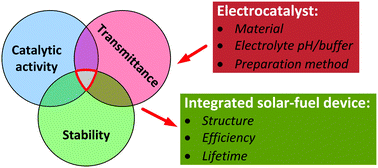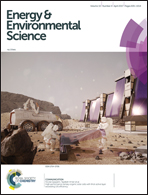A comparison of the chemical, optical and electrocatalytic properties of water-oxidation catalysts for use in integrated solar-fuel generators†
Abstract
The in situ optical properties and electrocatalytic performance of representative catalysts for the oxygen-evolution reaction (OER) have been considered together to evaluate system-level effects that accompany the integration of OER catalysts into a solar-fuel device driven by a tandem-junction light absorber with a photoanode top cell, i.e., a design that requires incident light to be transmitted through the OER catalyst before reaching a semiconducting light absorber. The relationship between the overpotential and optical transmission of the catalysts determined the attainable efficiencies for integrated solar-fuel devices as well as the optimal band gaps for the photoanode in such devices. The systems investigated generally showed: (1) the OER catalysts dissolved in acid, and were less stable in buffered near-neutral pH electrolytes than in strongly alkaline electrolytes; (2) higher overpotentials were required to drive the OER at a specified current density when the catalysts were operated in contact with near-neutral pH electrolytes than strong alkaline electrolytes; (3) for some of the OER catalysts, the electrocatalytic activity and in situ absorption spectra depended strongly on the preparation method; (4) increasing the loading of the electrocatalyst reduced the overpotential and the optical transmission; (5) for the catalysts studied, the optical transmission and overpotential were generally correlated, and the trend lines did not cross, indicating that based on these factors alone, the optimal approach is to use lower loadings of highly active catalysts, rather than to use a less active but more transparent catalysts; (6) for a solar-fuel device driven by semiconductors operating at the Shockley–Queisser limit and using a continuous film of a given OER catalyst in the path of incident light, the efficiency decrease due to the reduced optical transmittance that accompanies increased OER catalyst loading can be substantially greater than any efficiency increase that might be gained through the reduction in catalytic overpotential by increasing the catalyst loading; and (7) HER catalysts possessed the same performance trade-off when the light is incident through the HER catalysts as is observed for OER catalysts when the light is incident from the OER side.



 Please wait while we load your content...
Please wait while we load your content...